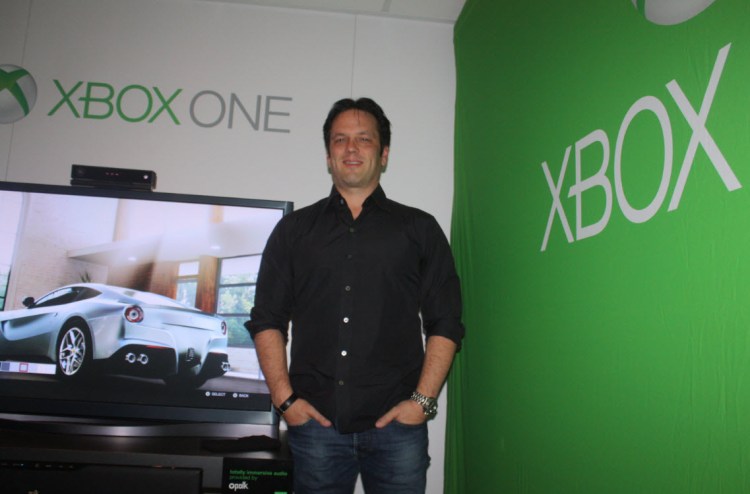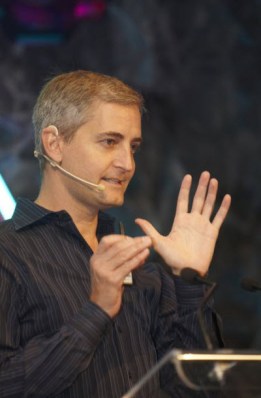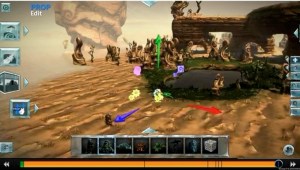GamesBeat: It looks like you have a lot more downloadable titles available this time.
Spencer: Yeah. We learned that through 360. At the launch of the 360 there was very little. The name “Xbox Live Arcade” hearkened back to playing old Centipede and Pac-Man games. With 360 we saw the emergence of this new channel for original things – maybe not the size of a Halo or a Call of Duty, a little smaller, but reaching a broad audience that way. State of Decay was an example of a release that did well for us.
So it wasn’t hard, at the launch of Xbox One, to find some unique, smaller games, but no less ambitious in terms of the creative impact they wanted to have, and make them available day one. If you do a good job, people will come in and buy them. There’s a viable business there for creators. That made it easy to get people to sign up.
GamesBeat: I wonder what some of your high-level thinking was at the beginning, a few years ago, when you were considering launch titles. I’ve had a chance, in the past, to talk to people like Ed Fries about what they thought about launching the new titles and brands on the 360 at the beginning. He resisted the box for a while because he felt like there wasn’t a new feature that was going to grab everyone. It had better graphics, but what was it doing that was brand new for people? He wanted something more like Kinect in the box at the start. So he had some interesting challenges as he was thinking about a new generation. I’m wondering what yours were.
Spencer: Ed hired me into the studio, so Ed and I have a lot of history in this space. I learned a lot from him, but I don’t know that I think about it exactly the same way. I don’t think about launch any differently than I do about our role as first party at any point in the generation. I want to be able to talk about any one of my games and explain why that’s a first party game. Why is this a game that — as a studio, either with our internal resources or externally with a development relationship — is being built as a first party?
As a business mechanic, first party is obviously not targeting the whole installed base. There are financial challenges from a pure title P&L, if you think about it. So we better have a real reason that we’re investing in something. Why is this a first party game? What I hear when you talk about Ed at the launch of Xbox 360, you really want to be able to look at every one of the games and understand why this is something that first party should be investing in. Third parties are going to invest in a lot of franchises and a lot of genres. I don’t need to tick all the boxes on a genre basis, or even from an age rating standpoint, because that stuff will be there.
So why is this a first party game? It’s one of the first questions I ask when people come in with a new concept. What makes this a first party experience? What can we invest in that a third party might not invest in?
 GamesBeat: Is that similar to thinking about something like: What’s our killer app going to be?
GamesBeat: Is that similar to thinking about something like: What’s our killer app going to be?
Spencer: Not always. The killer apps are more of the mythical beast that’s hard to catch. Look at retail Minecraft right now. It continues to blow the doors off after we sold so many millions of units digitally, on top of Mojang selling so many millions of units on PC. You can say that in a lot of ways Minecraft is a killer app, even though it came to us later than it did on PC. I don’t know what it is from our standpoint that would make that a first party app, but clearly it’s resonating with people.
Project Spark is a pretty good example. If we’re going to go off and build something around creativity, we want to make sure that we give people the ability to create on multiple devices and share with people on other devices. We want to be able to use things like Kinect to mocap. We want to be able to use different parts of the ecosystem to create something new. Project Spark is a big investment on our part. I don’t know if it’s an investment that any third party would naturally jump in and do. But for us, as a first party with a connected ecosystem across a lot of devices, it feels like a good investment. Or Zoo Tycoon, where we’re going to store zoos in the cloud and let people work collaboratively with the store. We could have just gone back to the old Zoo Tycoon and ported that, but we decided to invest in something that makes this special and unique to what we’re trying to do as a first party.
GamesBeat: With Spark, they talked to me about how Kinect is the hook for the Xbox experience. It’s something that the other platforms don’t offer. How far do you guys want to push Kinect at this point? With 360, it was something that came down the road. How much more important is the Kinect investment this time around?
Spencer: There are a few things I would say are unique differentiators for the Xbox brand. One of those is Xbox Live. When people think about Xbox, they think about Live. We’re investing in that ecosystem. Halo is probably the most definitive piece of IP behind the Xbox brand. But Kinect is clearly something that’s unique to us. Making sure that Kinect shows up as something that’s consumer-ready, that’s applicable across many things that people want to do, whether it’s watching TV, Skyping with their friends, playing games, or something completely different — maybe something uncategorizable like Spark — and making sure that it shows up as something important.
The nice thing about putting Kinect in from day one is that, even for something that’s a controller-based game, they know that everybody with an Xbox One has Kinect. It’s easy for them to think about things like voice. A majority of the games you see up there will use voice in some way because it’s easier to do certain things. Then you take something like Battlefield, where they have their lean controls. Lean was pretty easy for them, because we built Kinect into the OS. They don’t have to give up cycles to support that. They can incorporate lean as a sort of third thumb stick. A person can use their body that normally you’d have to modify one of the thumb sticks on the controller to do.
Making sure that Kinect shows up across core games, television, entertainment, communication, web browsing, all the things people do across all their devices is critical. It’s just like Live, or even Halo, as we take something like Halo that’s definitive to us and start bringing it to more platforms. There are some things that uniquely define what our brand is about.
GamesBeat: It looks like you’re able to build Kinect into the fabric of things, but it seems like you’re still looking for a blockbuster hit there.
Spencer: Maybe? I think about how many people use Kinect in the day-to-day operation of the Xbox One. It might not turn out that there’s a Minecraft moment for Kinect, where one thing causes everyone to say, “Oh, that’s it.” It might just become something like DVR. It’s not as if there was one TV show that took unique advantage of DVR and we all said, “Now I need it!” It was just that this was a better way to store all your TV than all these tapes.
Now, when my wife sits down and says, “Xbox, watch NBC,” and it turns right to NBC on the television, that’s pretty unique. She doesn’t have to remember that NBC high def is channel 105. All that stuff just happens. She’s able to seamlessly control what she sees on her television by using her voice. She doesn’t want to know how it happened. It just works. That could end up being the killer app for Kinect, something that’s as pervasive and expected as that.




